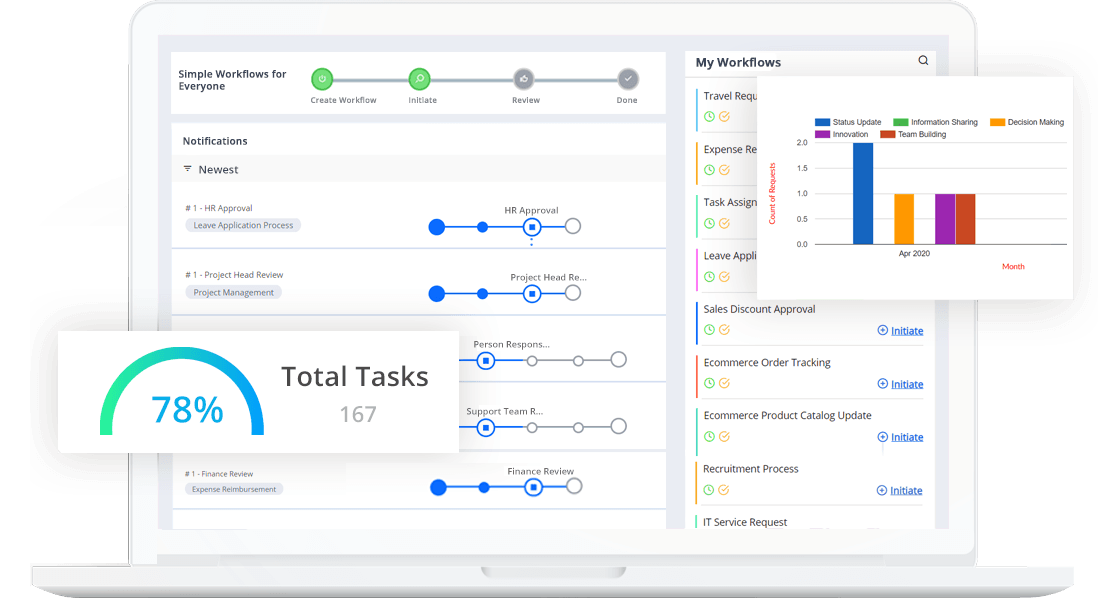The best software for automating repetitive tasks includes Zapier and Microsoft Power Automate. These tools streamline workflows, saving time and increasing productivity.
Best Software for Automating Tasks:Automation is revolutionizing how we manage daily tasks. Businesses and individuals alike are inundated with repetitive activities that can drain valuable time and energy. Thankfully, various software solutions exist to tackle this issue head-on. By automating mundane tasks, users can focus on higher-value work that drives growth and innovation.
Software like Zapier and Microsoft Power Automate offers intuitive interfaces and powerful integrations, making it easy to set up workflows. This not only enhances efficiency but also reduces the risk of human error. Embracing automation can transform how you approach your work and free you to explore new opportunities.
Introduction To Task Automation
Task automation simplifies work by using software to perform repetitive tasks. It helps save time and reduces errors. Businesses can focus on important projects. Automation makes daily activities smoother and more efficient.
Benefits Of Automating Repetitive Work
Automating repetitive tasks offers several key benefits:
- Increased Efficiency: Complete tasks faster without human intervention.
- Cost Savings: Reduce labor costs and eliminate mistakes.
- Improved Accuracy: Automation minimizes human error.
- Enhanced Focus: Employees can focus on creative tasks.
- Scalability: Easily manage increased workloads without extra staff.
How Automation Software Transforms Productivity
Automation software transforms productivity in several ways:
- Streamlines Workflows: Connects different tools for seamless operation.
- Tracks Progress: Monitors tasks and deadlines automatically.
- Reduces Burnout: Alleviates repetitive strain on employees.
- Supports Collaboration: Improves communication among team members.
With task automation, businesses can achieve more in less time. This technology turns repetitive tasks into smooth processes.
Criteria For Selecting Automation Software
Choosing the right automation software is crucial for efficiency. Several criteria help in making this choice. Focus on ease of use, integration capabilities, customization, and security features.
Ease Of Use
Software should be simple to navigate. A user-friendly interface saves time. Consider the following:
- Intuitive design
- Clear instructions and support
- Quick setup process
Trial versions help assess usability. Ensure team members can use it without extensive training.
Integration Capabilities
Automation software must connect with existing tools. Check for:
- API support
- Compatibility with popular apps
- Data import/export options
Integration saves time. It helps streamline workflows across different platforms.
Customization And Flexibility
Every business has unique needs. Choose software that allows:
- Custom workflows
- Adjustable templates
- Personalized settings
Flexibility helps adapt the tool as needs change. A customizable solution grows with your business.
Security Features
Data protection is vital. Look for software that offers:
- Encryption
- User access controls
- Regular security updates
Check for compliance with industry standards. Protecting sensitive data builds trust with clients.
Top Desktop Automation Tools
Desktop automation tools simplify repetitive tasks and boost productivity. They reduce human error and save time. Here are the top tools you can use to streamline your workflows.
Robotic Process Automation (rpa) Leaders
RPA tools mimic human actions to automate tasks. They work well with various applications. Here are some top RPA leaders:
| Tool | Description |
|---|---|
| UiPath | User-friendly interface with powerful automation features. |
| Automation Anywhere | Cloud-based platform with extensive support and resources. |
| Blue Prism | Focuses on security and scalability for large enterprises. |
Scripting And Macro Software
Scripting and macro tools allow users to create custom scripts. These scripts automate specific tasks efficiently. Popular options include:
- AutoHotkey: Open-source scripting language for Windows.
- Keyboard Maestro: Powerful tool for macOS automation.
- Excel Macros: Automate repetitive tasks in spreadsheets easily.
Workflow Automation Platforms
Workflow automation platforms integrate multiple apps and services. They help manage complex workflows with ease. Here are key platforms:
- Zapier: Connects over 2,000 apps for seamless automation.
- Integromat: Advanced automation with visual workflow builder.
- Microsoft Power Automate: Integrates well with Microsoft products.
Choose the right tool for your needs. Automate tasks and focus on what matters.

Credit: www.cflowapps.com
Leading Web Automation Solutions
Web automation tools simplify tasks and workflows. They save time and reduce errors. Many options exist for different needs. Below are some of the best tools available today.
Browser Extension Automators
Browser extensions enhance your web experience. They automate repetitive tasks directly in your browser. Here are some popular options:
- iMacros: Automates web tasks like form filling and data extraction.
- AutoFill: Saves and fills forms quickly.
- Web Scraper: Extracts data from web pages easily.
- Zapier: Connects your favorite apps and automates workflows.
| Extension | Key Features |
|---|---|
| iMacros | Record and replay web actions |
| AutoFill | Quick form-filling |
| Web Scraper | Data extraction from pages |
| Zapier | App integration and automation |
Cloud-based Automation Services
Cloud-based automation services offer flexibility. They allow you to automate tasks from anywhere. Here are some leading options:
- Zapier: Connects over 2,000 apps for seamless automation.
- Integromat: Visual automation tool for complex workflows.
- Automate.io: Simple setup for marketing and sales tasks.
- Microsoft Power Automate: Integrates with Microsoft services easily.
These services can streamline tasks significantly. They are user-friendly and require no coding skills.
Mobile Automation: Apps On The Go
Mobile automation simplifies daily tasks. It helps users manage workflows efficiently. The right apps can save time and reduce stress. Use them to automate repetitive tasks on your smartphone.
Task Automation Apps For Android
Android users have many options for task automation. Here are some top apps:
- Tasker: Create custom automation tasks with triggers.
- Automate: Use flowcharts to design automated tasks.
- IFTTT: Connect different apps and services seamlessly.
- MacroDroid: Simple interface for creating automation macros.
These apps allow you to:
- Set reminders based on location.
- Control devices with voice commands.
- Automate text messages and calls.
Choose an app that fits your needs. Each app has unique features that help you work smarter.
Ios Automation With Shortcuts
iOS offers a powerful tool called Shortcuts. This app helps users automate tasks easily. Users can create shortcuts for everyday actions.
Here are some popular uses for Shortcuts:
- Send a message: Quickly text someone with one tap.
- Set a timer: Start a timer with a voice command.
- Play music: Launch your favorite playlist instantly.
Shortcuts also support integration with other apps. This makes automation even more powerful. Users can:
- Create complex workflows using multiple apps.
- Schedule tasks to run at specific times.
- Utilize location-based triggers for actions.
iOS users can explore the gallery for ready-made shortcuts. Discover automation tailored to your lifestyle.

Credit: www.cflowapps.com
Automation Software For Coders
Automation software helps coders save time and effort. It reduces repetitive tasks. This allows developers to focus on important projects. Here are two key areas where automation shines: automated testing and build/deployment processes.
Automated Testing Frameworks
Automated testing frameworks help streamline the testing process. They ensure code quality and speed up feedback cycles. Here are some popular frameworks:
- Selenium: Ideal for web applications.
- JUnit: Great for Java applications.
- PyTest: Perfect for Python projects.
- Mocha: Excellent for JavaScript testing.
These frameworks provide:
- Automated test execution
- Detailed reporting
- Easy integration with CI/CD tools
Build And Deployment Automation Tools
Build and deployment tools simplify the release process. They ensure consistent and error-free deployments. Popular tools include:
| Tool Name | Description |
|---|---|
| Jenkins | Open-source automation server for continuous integration. |
| Travis CI | Cloud-based CI tool, ideal for GitHub projects. |
| CircleCI | Fast and scalable CI/CD tool for any environment. |
| GitLab CI | Integrated CI/CD for GitLab repositories. |
These tools offer:
- Automated build processes
- Version control integration
- Rollback capabilities
Ai And Machine Learning In Automation
AI and machine learning are changing how we automate tasks. These technologies help make processes smarter and faster. They save time and reduce errors. Businesses can focus on more important work. Here’s how AI enhances automation.
Predictive Automation Tools
Predictive automation tools use AI to forecast outcomes. These tools analyze data to make better decisions. They can predict trends and automate actions based on those predictions.
- Data Analysis: These tools examine large datasets quickly.
- Trend Prediction: They identify patterns to foresee changes.
- Action Automation: They automate tasks based on predictions.
| Predictive Tool | Key Features |
|---|---|
| Tool A | Forecasting, Data Visualization, Reporting |
| Tool B | Machine Learning, Real-time Analysis, Alerts |
Intelligent Process Automation (ipa)
Intelligent Process Automation combines AI with traditional automation. This makes processes more flexible and efficient. IPA can adapt to new information and changing conditions.
- Enhanced Decision-Making: IPA helps users make informed choices.
- Workflow Optimization: It improves efficiency in repetitive tasks.
- Seamless Integration: IPA works well with existing systems.
Using IPA leads to better results and higher productivity. Businesses can become more agile and responsive.
Case Studies: Success Stories
Many businesses have transformed their operations through automation. These success stories highlight how software can simplify tasks and boost productivity.
Small Business Automation Wins
Small businesses often face resource limitations. Automation helps them maximize efficiency. Here are a few success stories:
-
Startup X: This e-commerce business automated order processing.
- Result: 50% faster order fulfillment.
- Saved 20 hours per week.
-
Consulting Firm Y: They automated invoicing and client follow-ups.
- Result: Reduced billing errors by 30%.
- Improved cash flow significantly.
-
Cafe Z: They used software for employee scheduling.
- Result: Increased staff satisfaction.
- Reduced scheduling conflicts by 40%.
Large Enterprises Streamlining Processes
Large enterprises benefit from automation on a grand scale. Here are some examples:
| Company | Automated Process | Results |
|---|---|---|
| Global Corporation A | Inventory Management | Decreased stock shortages by 60%. |
| Tech Giant B | Customer Support | Improved response time by 70%. |
| Finance Firm C | Data Entry | Cut data processing time by 80%. |
These examples show how automation leads to significant gains. Businesses of all sizes can achieve similar results.
Future Of Task Automation
The future of task automation is bright and promising. Businesses will increasingly rely on automation to boost efficiency. Repetitive tasks will be managed by software, freeing up human resources for creative work. This shift will change how we work and collaborate.
Emerging Trends In Automation Technology
Several trends are shaping the future of automation technology:
- Artificial Intelligence (AI): AI enhances decision-making and efficiency.
- Robotic Process Automation (RPA): RPA handles repetitive tasks easily.
- Low-Code Platforms: These allow users to create automation without programming.
- Integration of IoT: Internet of Things devices will streamline processes.
| Trend | Description |
|---|---|
| AI | Improves workflows and reduces errors. |
| RPA | Automates data entry and processing tasks. |
| Low-Code | Empowers non-tech users to automate easily. |
| IoT | Connects devices for seamless automation. |
Preparing For An Automated Workplace
Preparing for an automated workplace requires several steps:
- Assess current workflows and identify repetitive tasks.
- Choose the right automation tools for your needs.
- Train employees on new technologies and processes.
- Monitor performance and adjust strategies as needed.
Embracing automation can lead to significant advantages. Increased productivity, reduced errors, and improved employee satisfaction are just a few benefits. Companies that adapt will thrive in the future.

Credit: salientprocess.com
Final Thoughts On Choosing The Right Tool
Choosing the right software for automating repetitive tasks is crucial. The right tool can save time and boost productivity. Focus on your specific needs and future growth.
Assessing Your Automation Needs
Start by evaluating your current tasks. Identify which tasks are repetitive. Consider the time spent on these tasks.
- List out all repetitive tasks.
- Prioritize tasks based on time consumption.
- Determine which tasks can be automated easily.
Ask these questions:
- What tasks waste the most time?
- Which processes require the most manual input?
- How often do these tasks occur?
With this assessment, you can narrow down your options. Pick software that aligns with your specific needs.
Investing In Scalable Solutions
Choose software that grows with your business. Scalability ensures you don’t need frequent upgrades. The right tool adapts to changing needs.
Consider these factors:
- Number of users: Ensure it accommodates future team members.
- Integration: Check compatibility with other tools.
- Features: Look for features that can expand over time.
A scalable solution saves costs long-term. Avoid tools that may restrict your growth.
| Feature | Importance |
|---|---|
| User Capacity | High |
| Integration Options | Medium |
| Customizable Features | High |
Invest wisely in automation tools. They should support your goals and help your business thrive.
Frequently Asked Questions
What Are The Benefits Of Automating Workflows?
Automating workflows increases efficiency and productivity. It reduces human error and saves time on repetitive tasks. By streamlining processes, teams can focus on strategic initiatives. This leads to better resource allocation and improved overall performance. Ultimately, automation fosters innovation and enhances business agility.
Which Software Is Best For Task Automation?
Top software options for task automation include Zapier, Integromat, and Microsoft Power Automate. Each offers unique features tailored to various needs. Consider your specific requirements like integrations, ease of use, and pricing. Evaluating these aspects will help you choose the best tool for your workflow automation.
How Does Automation Improve Productivity?
Automation enhances productivity by minimizing repetitive tasks. It allows employees to focus on more critical work that requires creativity and problem-solving. By streamlining processes, teams can complete projects faster and with greater accuracy. This results in improved morale and better job satisfaction among employees.
Can Automation Reduce Operational Costs?
Yes, automation can significantly reduce operational costs. By decreasing manual labor and speeding up processes, companies save on labor costs. Efficient workflows also minimize errors, which can lead to costly fixes. Overall, investing in automation tools pays off by enhancing profitability and resource management.
Conclusion
Automating repetitive tasks can significantly boost productivity and efficiency. The right software helps streamline workflows and saves valuable time. By implementing these tools, you can focus on more critical aspects of your work. Choose the software that best fits your needs to enhance your productivity and simplify your daily operations.




Leave a Reply